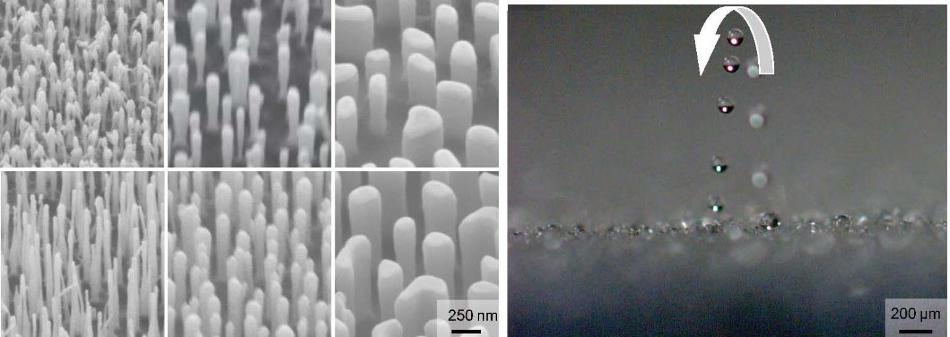Aug 1 2017
With better understanding of the behavior of water in its smallest form, a Virginia Tech Professor and his Undergraduate Student are trying to enhance the efficiency of removing condensation in a major way.
 Essentially, when the nano pillars are tall and slender, the droplets formed inside and on the crevices can jump off the surface at a much smaller size, down to two micrometers. Likewise, short and stout pillars increase the size of the droplet required to jump -- up to 20 micrometers in the case of Mulroe's experiment. Credit: Virginia Tech
Essentially, when the nano pillars are tall and slender, the droplets formed inside and on the crevices can jump off the surface at a much smaller size, down to two micrometers. Likewise, short and stout pillars increase the size of the droplet required to jump -- up to 20 micrometers in the case of Mulroe's experiment. Credit: Virginia Tech
Jonathan Boreyko, an Assistant Professor in the Department of Biomedical Engineering and Mechanics in the Virginia Tech College of Engineering, has been studying "jumping" dew droplets from the time he discovered the phenomenon in graduate school.
Boreyko believes that, dew droplets jump from water-repellent surfaces, only when they achieve a large enough size (about 10 micrometers). However, this reason was still unclear until Boreyko and his students could make a breakthrough discovery. This finding will soon be published in the high-impact journal ACS Nano.
In Boreyko's lab, then-undergraduate Megan Mulroe carried out experiments with the surface of silicon chips to study the impact of nanoscopic surface topography on the jumping ability of condensation.
Six different types of surfaces covered with so-called nanopillars – reminiscent of stalagmites on a cave floor – were created and tested by Mulroe. This helped him conclude that the vital size of the jumping droplet can be fine-tuned based on the pitch, diameter and height of the nanopillars.
These results, correlated with a theoretical model, revealed that the bottleneck for jumping is how the droplets inflate inside of the surface after they first form.
Jonathan Boreyko, an Assistant Professor in the Department of Biomedical Engineering and Mechanics, the Virginia Tech College of Engineering
Basically, when the nanopillars are slender and tall, the droplets formed within and on the crevices can jump off the surface at a much smaller size, down to two micrometers. Similarly, short and stout pillars raise the size of the droplet needed to jump - up to 20 micrometers in the case of Mulroe's experiment.
While it has already been discovered that the effective form of condensation removal is the jumping droplets phenomena, the ability to tweak the size of the droplets can also enable enhanced efficiency in removing condensation from surfaces.
We expect that these findings will allow for maximizing the efficiency of jumping-droplet condensers, which could make power plants more efficient and enable robust anti-fogging and self-cleaning surfaces. The ultimate goal is for all dew droplets forming on a surface to jump off before they are even visible to the eye.
Jonathan Boreyko, an Assistant Professor in the Department of Biomedical Engineering and Mechanics, the Virginia Tech College of Engineering
All of the experiments were conducted by Mulroe, who was first Author on the paper. The Graduate Student Farzad Ahmadi, who is pursuing a Ph.D. in Engineering Mechanics, backed up the findings using a theoretical model.
On July 31st, the research will be published in ACS Nano.